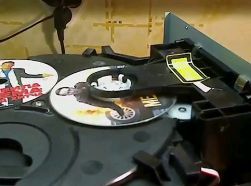Categories: Sharing experience, Practical Electronics, Repair of household appliances
Number of views: 43892
Comments on the article: 4
What to do if the karaoke center does not read DVD discs
 One of the most common malfunctions of modern DVD players is poor reading of data from the disc or even a complete lack of reading. There are about a dozen reasons for this problem. One of the first on the list is the loss of the emission of a laser diode, both a CD and a DVD diode. More often than the last.
One of the most common malfunctions of modern DVD players is poor reading of data from the disc or even a complete lack of reading. There are about a dozen reasons for this problem. One of the first on the list is the loss of the emission of a laser diode, both a CD and a DVD diode. More often than the last.
Hence the selective reading, that is, the device does not read DVD discs, but perfectly “catches” and plays CDs. Or exactly the opposite. As repair practice shows, on average, the head of a DVD player lasts from 3 to 5 years. And every year this figure decreases, as well as the cost of heads.
What to do if your player does not read DVD discs, treacherously signaling “NO DISK” for all your attempts to watch your favorite movie after a hard day? Well, as I said, there can be about a dozen reasons.
First of all, you need to make sure that the lens of the laser head is not dusty. If dust is visible on the lens, gently wipe it with a dry cotton swab. In addition, it is necessary to blow through the optical system, or, in simple terms, blow into the head. Naturally, you need to do this either from a cylinder with compressed air or with the help of a pear (enema).
Blowing from the mouth is the worst option, which will lead to even worse reading. Particles of moisture and saliva in the exhaled air will fall on the mirror and prism. Having dried, they will leave a trace that will impede the passage of the laser beam.
Next, check the spindle motor. This is the very motor that spins the disc. If it rotates, does not mean that it is serviceable. Just often it is he who becomes the reason when your device does not read DVDs but reads CDs. There are several ways to test it, but the best is replacement.
And finally, the actual emission of laser diodes. Only head replacement will help here. In addition, at the head, or if it is correctly called, an optical converter, in addition to the loss of emission, the photo detector also fails.
In the video, you can look at a specific example of how the optical converter at the karaoke center changes. There are 5 main types of laser heads. And each has its own nuances and subtleties when replacing.
See also on this topic:Home appliance repair lessons on video
See also at bgv.electricianexp.com
:
